Su-30: it turned out somewhat different from what was planned
Our story started way back in 1988. It was then that the decision was made to start work at the Sukhoi Design Bureau on a new aircraft. Above the new two-seat aircraft.
An analysis of the practice of using fighters in modern conflicts made it possible to direct the efforts of designers in two directions.
1. Modern air combat began to impose huge loads on the pilot. Piloting a vehicle with simultaneous control and use of a weapon complex has become a really difficult task. An understanding came of the need to divide duties into two crew members, the first would be responsible for piloting the aircraft, the second would control the weapons.
2. As the attention of many countries turned to the North, it became clear that a small number of airfields, guidance points and AWACS aircraft in our North require the use of aircraft with a long flight duration. The Su-27 had very impressive fuel reserves, but this also hid a drawback: by the time the combat mission began, the pilot could get tired of the long duration of the flight.
So the second crew member, able to replace the pilot in a long flight and relieve part of the load during the battle, was a real way out of this situation.
The retrofitting of the Su-27UB aircraft (two-seat combat training aircraft) with an in-flight refueling system and indicators of the tactical situation - this is the group of engineer I.V. Emelyanova saw the solution to the problem.
The work was carried out at the Irkutsk Production Association and by 1992 ended with the creation of an aircraft, which was called the Su-30. In parallel with the new aircraft, the Sukhoi Design Bureau was working on a modification of the Su-27, which was called the Su-27P.
The aircraft were very different, and the new Su-30, unlike the Su-27, was designed for slightly different tasks:
- gaining air supremacy;
- long-range patrolling and escort of strategic aircraft aviation;
- radar patrol, guidance and target designation for other aircraft;
- flight crew training.
The Su-30 was perfect for combat missions at a considerable distance from airfields, or those associated with a long flight time. In addition, the presence of a second crew member made it possible to more effectively control the fighters in the group.
This was provided by a whole complex of equipment installed on the aircraft. In addition to the air refueling system, the Su-30 was equipped with a long-range navigation system, equipment for controlling fighters in a group, and an improved life support system.
At the same time, the aircraft, which was considerably heavier compared to the Su-27P, could easily perform all aerobatics on a par with single-seat fighters, and was capable of performing dynamic braking - the Pugachev Cobra.
A very decent (9400 kg) fuel supply ensured a flight range of 3600 km, and the presence of refueling equipment and tankers in the air generally limited the flight time and range by the physical capabilities of the crew. After numerous studies, it was decided to limit the time in the air to 10 hours.
In July 1998, the 148th Center for Combat and Flight Personnel Training under the leadership of Colonel Karapetyan carried out research to determine the possibilities for the joint use of the Su-30 and MiG-31B.
A group of aircraft (two MiG-31Bs and four Su-30s), taking off from an airfield in the center of the European part of Russia, was supposed to hit targets at the Ashuluk training ground in the Astrakhan region and intercept a mock enemy over the White Sea.
The group was supported by an A-50 AWACS aircraft and two Il-78 tankers. A-50 patrolled in a specially designated area, monitored the air situation and coordinated the actions of a group of fighters. The MiG-31Bs were in the forward echelon, detecting targets at a distance of up to 200 km with their excellent locators and transmitting information about them to the pilots of the Su-30 aircraft, which, according to the plan of the operation, were supposed to attack the targets. The flight route was 8500 km, the aircraft spent about 10 hours in the air. Three air refuelings were made.
In 1998, a group of the same size escorted a group of Tu-160 and Tu-95MS strategic bombers to Novaya Zemlya.
So, on the basis of a combat training aircraft, a long-range fighter appeared, capable of solving a wide variety of tasks in the air. The only drawback of the aircraft was its complexity, because of this, the production of the Su-30 went at a very low pace.
On the basis of the Su-30, an export version of the aircraft, the Su-30K, was developed, intended for deliveries to other countries. There are 12 such countries so far.
The power plant of the Su-30 is almost identical to the Su-27 and consists of two turbojet engines with afterburners AL-31F.
The armament of the Su-30 consists of a single-barreled automatic gun GSh-310 with a caliber of 30 mm and an ammunition load of 150 rounds. The gun is installed in the influx of the right side of the wing.
Rocket armament is located at 10 points: 4 - under the wing consoles, 2 - under the wingtips, 2 - under the engine nacelles and 2 - under the center section between the engine nacelles.
The aircraft can carry up to 6 medium-range air-to-air missiles of the R-27 type or various modifications (R-27ET, R-27ER). On the underwing nodes, 4 short-range missiles of the R-73 type can be placed.
It is worth mentioning stealth, which is so fashionable today. The Su-30 is strikingly different in this regard from fifth-generation aircraft, which prefer to attack targets by relying on AWACS with their powerful search radars that highlight targets for fighters.
The Su-30 itself searches for and destroys targets, relying on the work of its electronic systems, without the help of an AWACS aircraft, which can be considered a kind of weak link, because a bulky and slow aircraft is perfectly intercepted by complexes of the S-400 type with special 40N6E missiles designed specifically for destruction such aircraft. And for enemy interceptors, the AWACS aircraft is a very simple target.
For the Su-30, in terms of classification, “4 ++” is applicable, and this is really not a fifth-generation aircraft, quiet and secretive, striking from long distances, but which must be driven by the hand. The Su-30 is an aircraft that operates on its own, and the invisibility of fifth-generation machines in it is compensated by the most powerful electronic warfare equipment. In our case, this is so far "Sorption-S" and "Khibiny", "so far" - this is because in the future there are newer aviation electronic warfare systems.
The use of existing complexes in combat conditions has shown that they are able to cope not only with fighter radars, but also with air defense systems. The issue of fifth-generation fighters, behind which target designation aircraft loom, is still open.
Su-30MK
This aircraft made its first flight in 1999. It should be mentioned separately, since the difference between the Su-30 and Su-30MK is very significant.
The idea was this: on the basis of a long-range fighter-interceptor, to create a strike aircraft for front-line aviation. The name Su-30MK testified that the aircraft was primarily intended for export sales. It was believed that the aircraft would be able to cope not only with the destruction of air targets, like its predecessor, but also successfully attack ground and sea targets.
The Su-30MK already had 12 suspension points, 10 of them could be equipped with guided missile weapons. The total weight of the weapons was 8 kg.
To work on air targets, all the same all-aspect missiles with different guidance systems R-27R1, R-27RE, R-27TE, RVV-AE and R-73 were used.
Sea and ground targets were supposed to be destroyed by Kh-31P missiles (anti-radar missile), Kh-25ML, Kh-29L, Kh-29T, Kh-59M cruise missiles with remote control, corrected by KAB-500 aerial bombs. Plus, it was possible to use a wide range of conventional unguided rockets and bombs.
The Kh-31P could hit all types of radars of medium and long-range anti-aircraft missile systems without the aircraft entering their affected area, the Kh-59M generally worked on the “fire and forget” principle. In general, the range of weapons was more than impressive.
The Su-30MK was to be equipped with a new weapons control system and a new radar. This was required by new high-precision weapons placed on the aircraft, and new equipment was to maximize the effectiveness of its use in all weather conditions.
However, it turned out that the internal volume of the fighter was not able to accommodate all the necessary equipment. Partially it was necessary to place the control equipment on the nodes of the external suspension. For example, a laser targeting and ranging system for missiles with laser seekers and a thermal imaging system for monitoring and detecting targets in the infrared range were located in hanging containers.
Both cockpits in the Su-30MK were made identical in terms of control of both the aircraft and weapons.
This made it possible to distribute control responsibilities between the two pilots. The Su-30MK became capable of loitering in the air for up to 10 hours of flight time.
The ways of using the new aircraft have also expanded. If the Su-30 was intended to combat air targets as a fighter-interceptor, then the Su-30MK added the search and destruction of sea and ground targets to the Su-30's ability to gain air superiority, escort bombers and long patrols.
The aircraft got fatter, the maximum takeoff weight increased from 30 to 38,8 tons, the combat load also increased from 4 to 8 tons.
Despite the fact that the Su-30MK became a participant in a large number of air shows, no one was in a hurry to purchase the aircraft. A common practice in the world: you should not buy an aircraft that is not in service with the country of manufacture. But the Russian Ministry of Defense did not seek to acquire the Su-30MK, and everything was ugly with the funds.
Meanwhile, the aircraft was very different from the Su-30. The differences should be mentioned separately, because it is easier to understand the amount of work done by the Sukhoi Corporation:
- an additional front horizontal tail appeared, which was installed in the influx of the wing;
- AL-31PF engines with thrust vector control;
- color LCD displays in the new indication and warning system;
- doubled combat load;
- two additional suspension points for weapons;
- the possibility of destroying sea and land targets with the corresponding types of weapons;
- a new radar sighting system capable of detecting and tracking up to 15 air targets while simultaneously attacking four of them;
- satellite navigation system based on GLONASS;
- helmet-mounted target designation system.
It is worth saying a few words about the latter. On the Su-30MK, a target designation system was worked out in practice, which was carried out by turning the pilot's head in the direction where the target was expected. The optical-laser tracking system scanned the space in the sector and issued instructions to the missile homing heads.
The fuel reserve compared to the Su-30 was reduced to 5 kg, which ensured a flight duration of up to 270 hours. With in-flight refueling, the flight duration increased to 4,5 hours. The Su-10MK could during this time fly up to 30 thousand kilometers at an altitude of 8-11 km.
Sioux 30M2
The next aircraft in the Su-30 family was more fortunate. Only 2010 years passed from the moment of the first flight in 4 to receiving a place in the state defense order. In 2014, the first aircraft
Su-30M2 were shipped from the plant in Komsomolsk-on-Amur to the Ministry of Defense.
Su-30M2 was created on the basis of the Su-30MK2 version, but was intended for the Russian Air Force. The fighter was intended to destroy both manned and unmanned aerial vehicles in the air at short and medium distances. With the use of appropriate weapons, the Su-30M2 could hit ground and sea targets in weather conditions of varying degrees of adverse weather and in electronic countermeasures.
It differed from the basic version of the Su-30M2 by its increased flight range and updated on-board equipment.
The main differences between the Su-30M2 are:
- increased flight range;
- a radically modified weapons control system;
- new display system in the cockpit;
- improved communication and navigation equipment;
- updated airborne defense system.
The new weapon control system provided search, detection, tracking and destruction of targets in all weather conditions and at any time of the day.
The weapon control system consists of two independent systems.
The first controls air-to-air missiles and consists of an aiming system, a radar, an optical-electronic aiming system and a windshield display system.
The second system provides for the use of the entire range of air-to-surface weapons, both conventional and high-precision. Data on the operation of the system is displayed on four multifunctional indicators on the instrument panels of the pilots.
Otherwise, according to its characteristics, the Su-30M2 does not stand out from the general range. The Su-30M2 was the first aircraft of this family to enter service with the Russian Aerospace Forces.
However, if we compare it with the Su-30SM and Su-35, then the Su-30M2 is significantly inferior to these models. Experts believe that this is due to the fact that the Su-30MK2 or MKK commercial vehicle was taken as the basis, that is, the export version created in Komsomolsk-on-Amur for China.
It was noted that the Su-30M2 model has a significantly lower modernization potential compared to other aircraft of the family.
The role assigned to the Su-30M2 in modern doctrine is to support single-seat fighters in air combat and use them as all-weather fighters.
Sioux 30SM
This machine was developed at the Sukhoi Design Bureau as part of the work on the creation of modern highly maneuverable fighters.
The aircraft possessed super-maneuverability, was equipped with a radar with an active phased antenna array, engines with a controlled thrust vector AL-31FP.
The fighter jet made its first flight in 2012.
In fact, the Su-30SM is a Russified version of the Su-30MKI aircraft, which was created in the late 90s by order of the Indian Air Force. However, the Su-30SM does not have on board the fruits of international cooperation. The Su-30MKI had quite a lot of systems developed or produced in countries such as France and Israel, with all the ensuing consequences.
This is a heavy fighter or even a multi-purpose aircraft, since the Su-30SM is capable of not only conducting maneuverable air combat or intercepting enemy aircraft, but also striking ground targets, both stationary and mobile. The aircraft can also be used to attack surface ships.
The layout of the systems in the fuselage repeats the Su-30 and Su-30MKI.
An important feature of the Su-30SM is its flight instability in the longitudinal channel. In order to avoid yaw and not strain the pilots with the difficult tasks of piloting such an aircraft, a separate electronic system controls the rudders and deflected nozzles of the engines. Engine nozzles can deviate both synchronously with the rudders and planes, and separately from them.
The aircraft is equipped with the H0011M Bars radar control system, which is capable of tracking up to 15 targets and hitting 1 short-range target or 4 long-range targets, moreover, to do this in the condition of electronic countermeasures.
The phased antenna array is rightly criticized for its weight and size, but it is thanks to the phased array that the aircraft gains an advantage in detecting the enemy first.
The information received from the radar and processed by the onboard computer system is projected onto the windshield and into the pilots' helmet-mounted target designation system. In addition, information is displayed on the multifunctional LCD screens of the pilots, which allows the pilots to have the highest level of assessment of the environment.
It is believed that the Bars radar is also capable of detecting fifth-generation "invisibles".
The design of the Su-30SM also does not use stealth technology. Similarly, the Su-30 is an aggressive aircraft, therefore, the Sorption and Khibiny electronic warfare systems were used in the defense system.
The electronic systems of the Su-30SM have an open-type architecture, that is, the inclusion of new weapons systems or electronic warfare in the avionics will be as simple as possible to adapt. This is what makes the Su-30SM a very versatile aircraft capable of changing its specialization from a fighter-interceptor to a strike aircraft in the shortest possible time.
LTH Su-30SM
Wingspan, m: 14,70
Aircraft Length, m: 21,94
The height of the aircraft, m: 6,375
Wing area, м2: 62,00
Weight kg
- normal takeoff: 24 900
- maximum take-off: 34 500
- fuel: 9 640
Engines: 2 x turbofan AL-31FP x 12800 kgf
Maximum speed km / h
- at height: 2 125
- near the ground: 1 350
Practical range, km: 3 000
Practical ceiling, m: 17 300
Crew, prs: 2
Armament:
- 30-mm gun GSH-301 with 150 rounds of ammunition;
- 8000 kg combat load on 12 pylons.
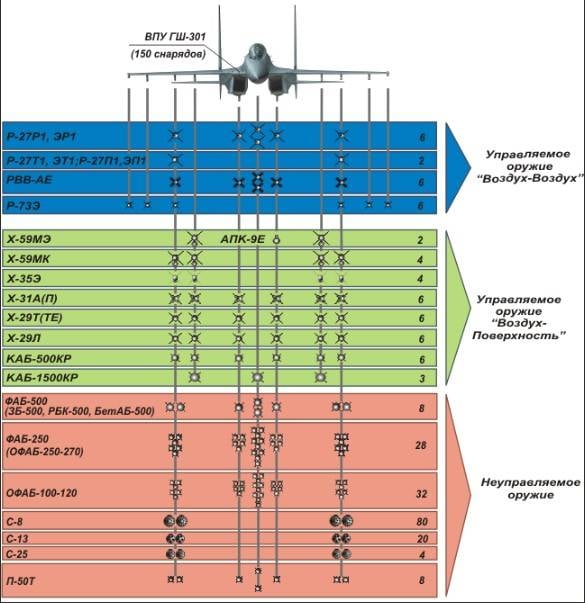
Combat load may include:
- up to 6 air-to-air missiles R-27R / ER, R-73E and R-77 (RVV-AE);
- 2 missiles R-27P (EP), R-27T1 (ET1);
- up to 6 air-to-surface missiles of the Kh-29T/L, Kh-25ML, Kh-25LD, Kh-31A/P and S-25L types;
- 2 Kh-59ME cruise missiles;
- 6 bombs KAB-500KR, KAB-500OD or
- 3 KAB-1500KR, KAB-1500L
- free-falling bombs of calibers from 100 to 500 kg;
- 8 bomb cassettes RBC-500 SPBE-D;
- up to 8 incendiary tanks ZB-500 PT
- NURS S-8, S-13 and S-25.
Suspension of containers with electronic warfare equipment, laser rangefinder and target designation systems, IR stations is also provided.
As a result, we can say that the attempt to "plug holes" in the military doctrine in the 90s, caused by the sad state of the military budget and all the Armed Forces of the Russian Federation as a whole, turned out to be more than successful. It turned out to create a really useful and, most importantly, versatile aircraft with good flight characteristics and an impressive set of weapons.
But they really only wanted to save on airfields in the North ...
However, the combat use of the Russian Aerospace Forces aircraft in Syria and during a special operation in Ukraine, as well as the use of Indian Air Force aircraft, showed the real value and real capabilities of the Su-30.
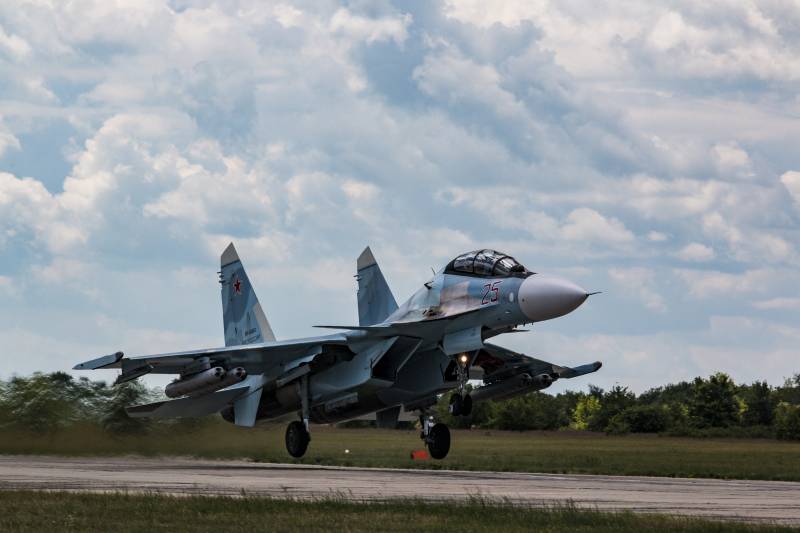
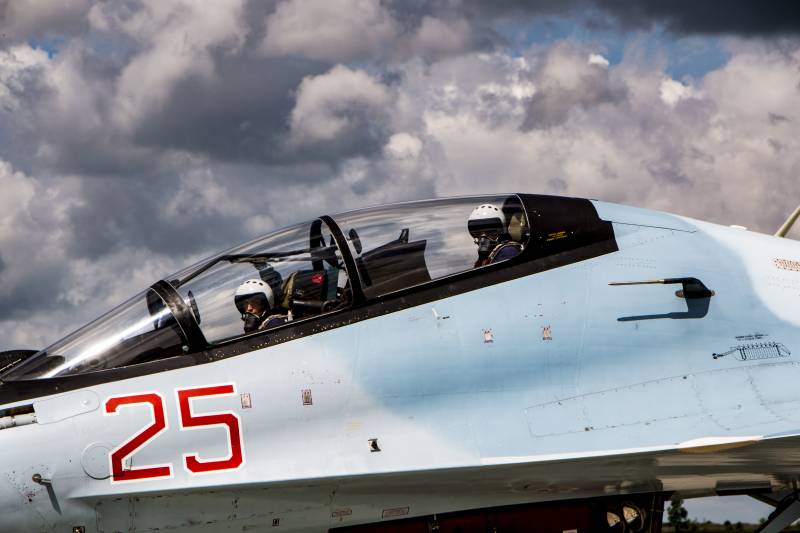
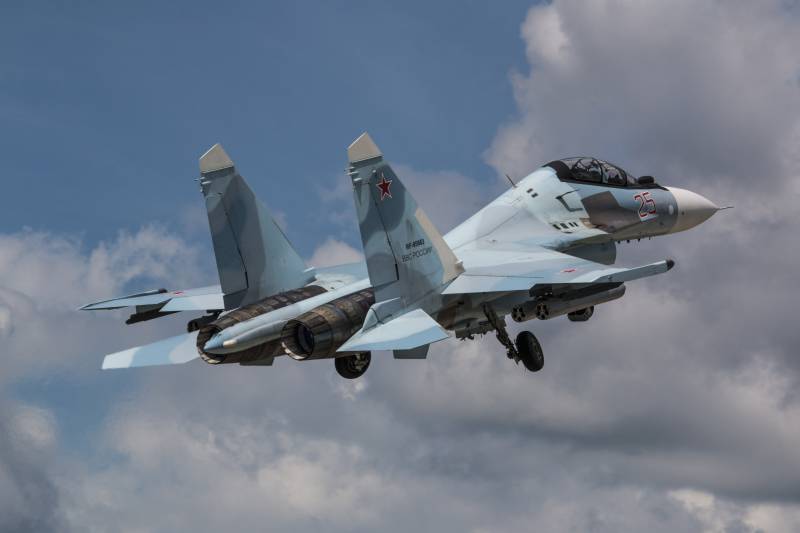
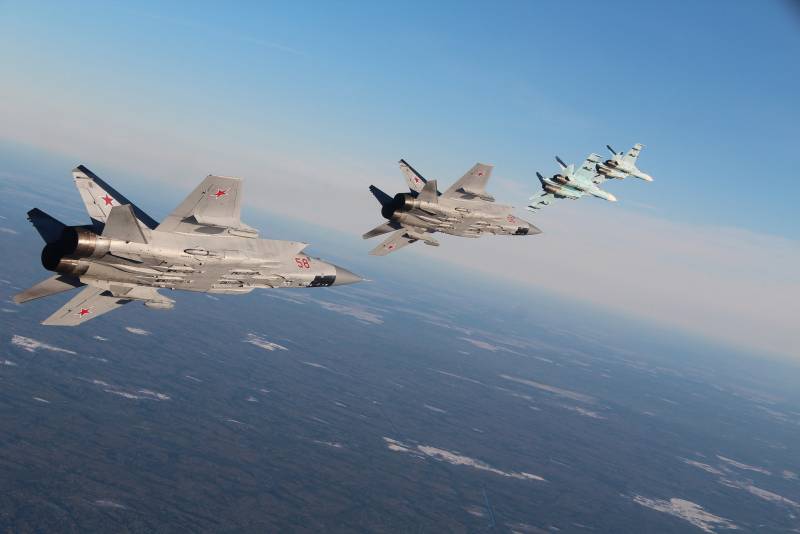
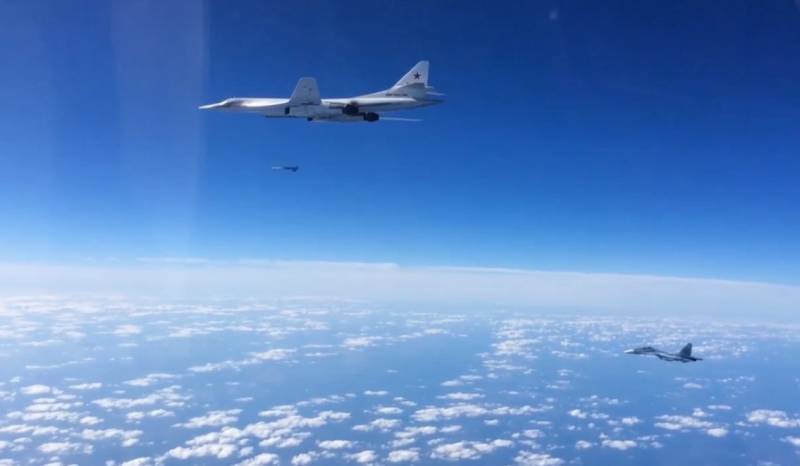
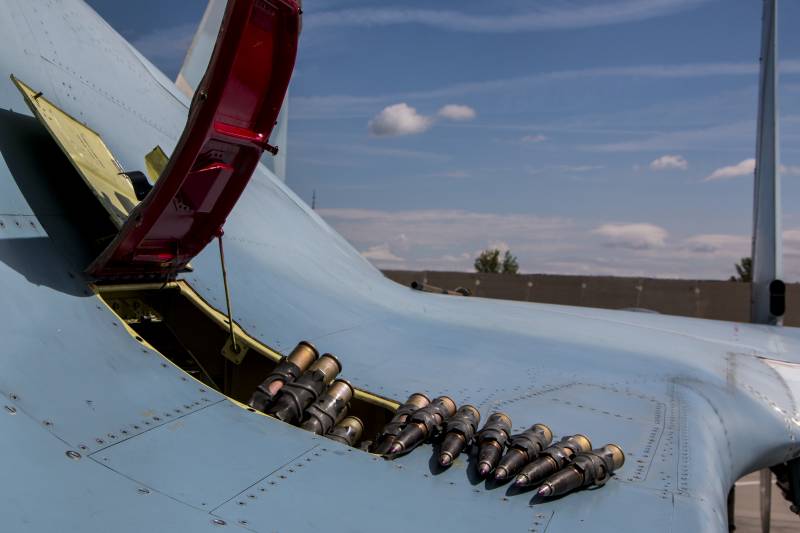
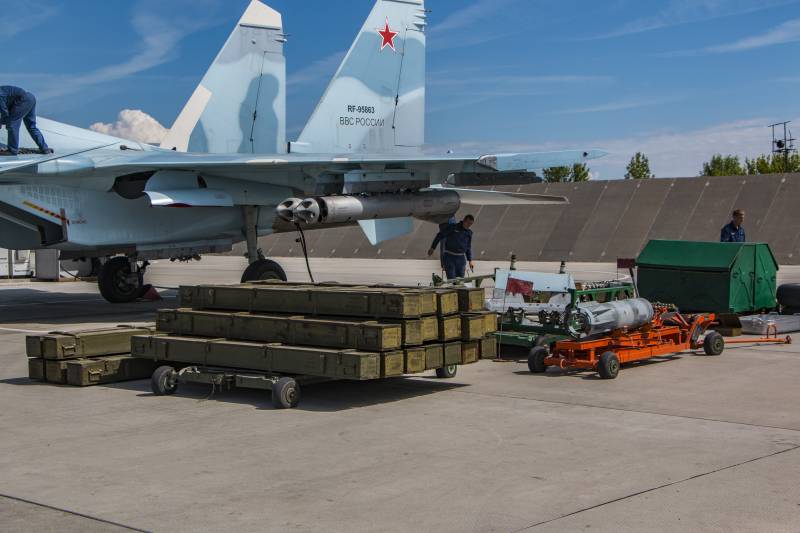
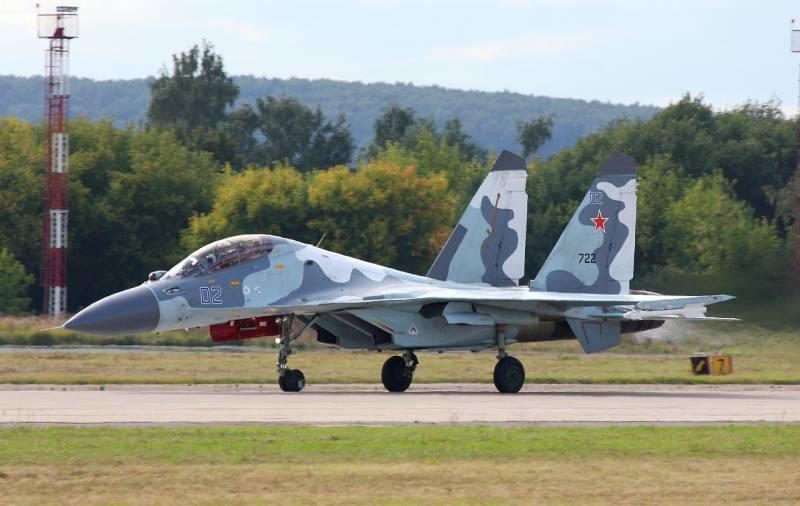
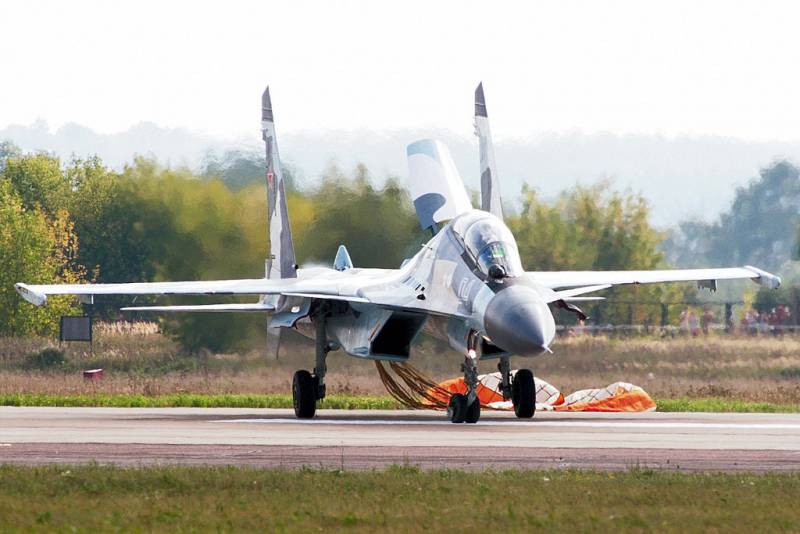
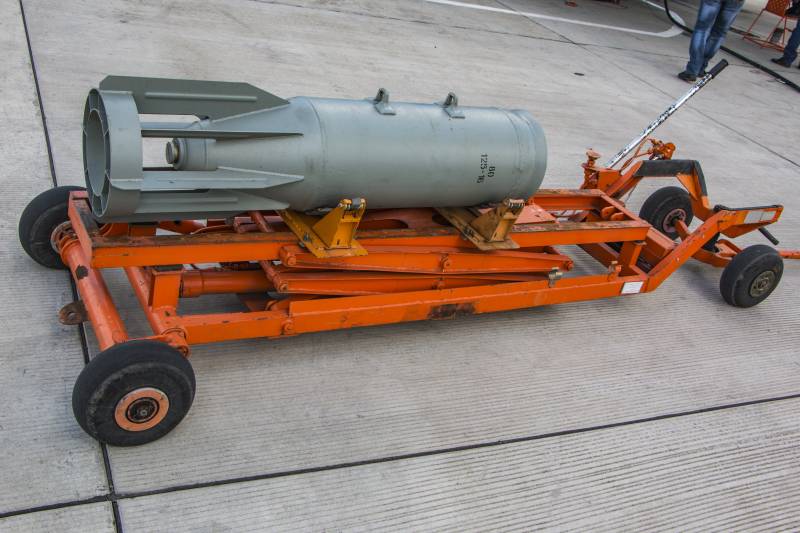
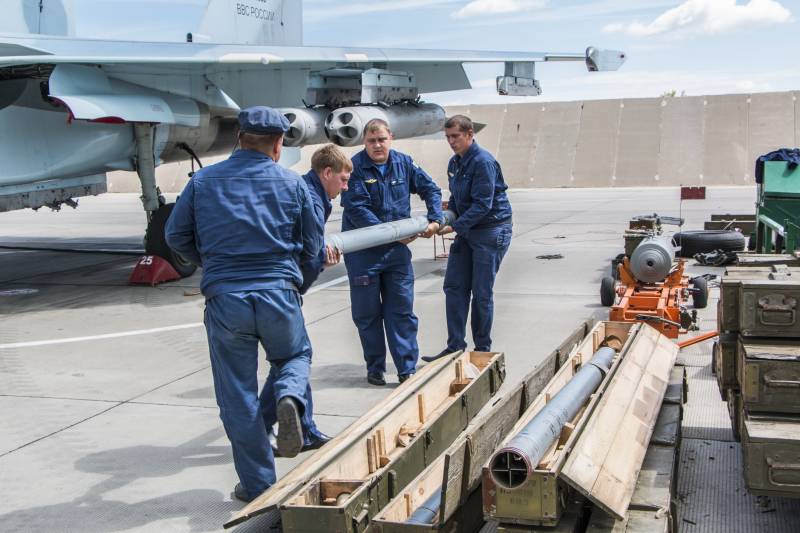
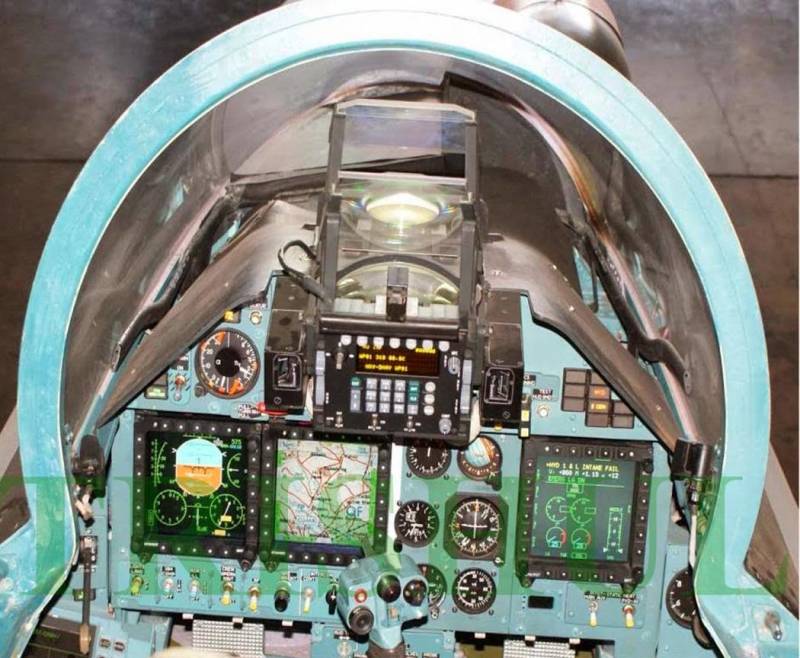
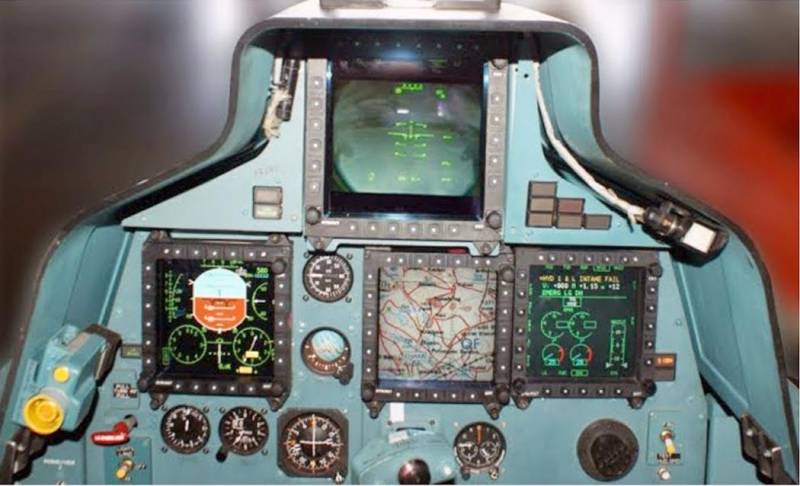
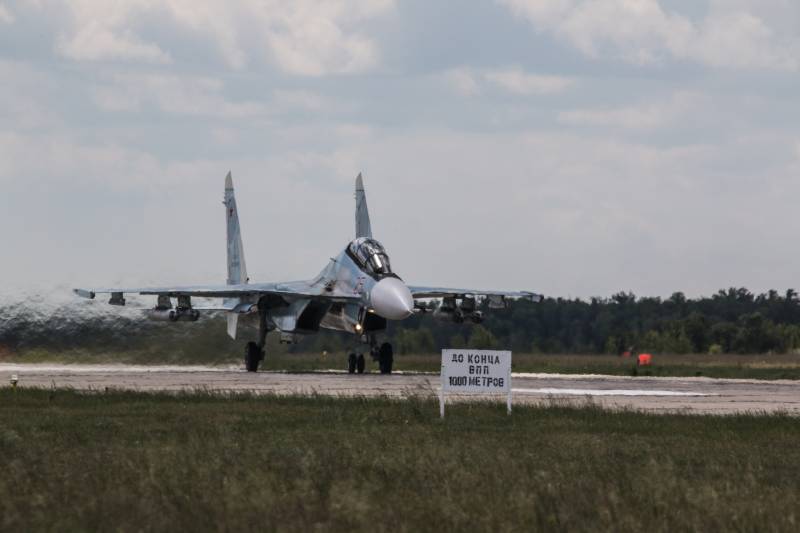

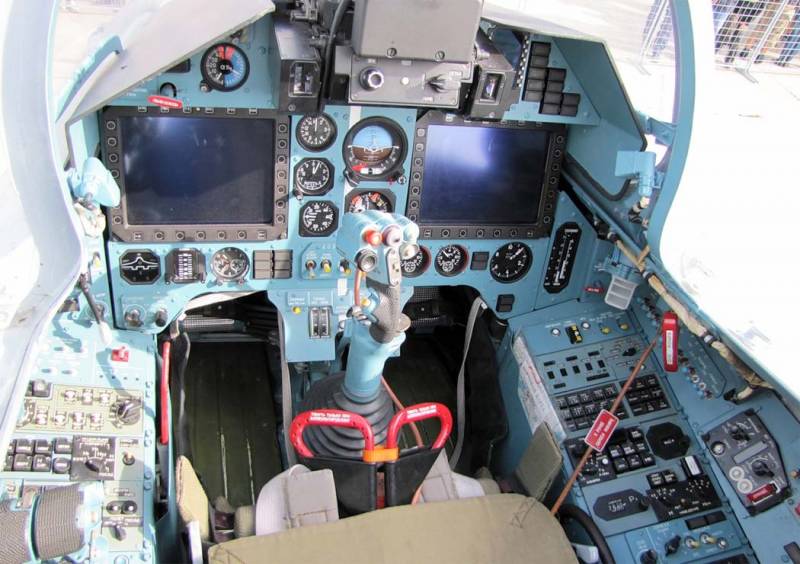
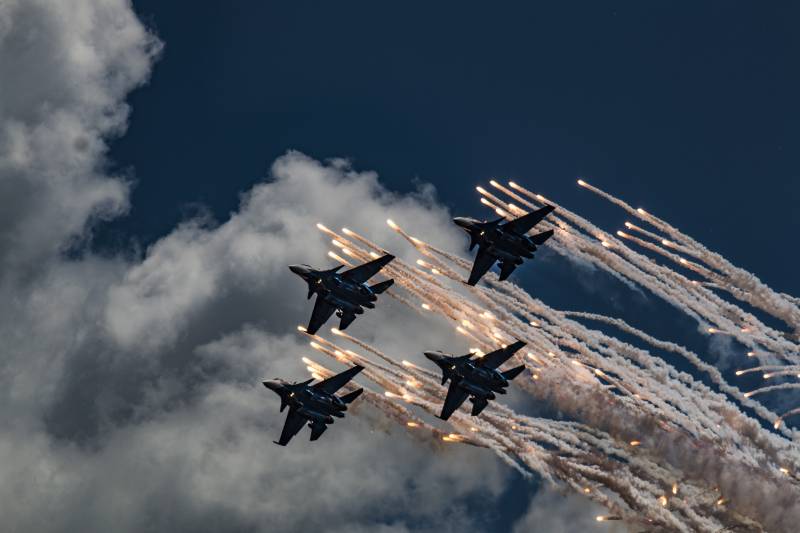
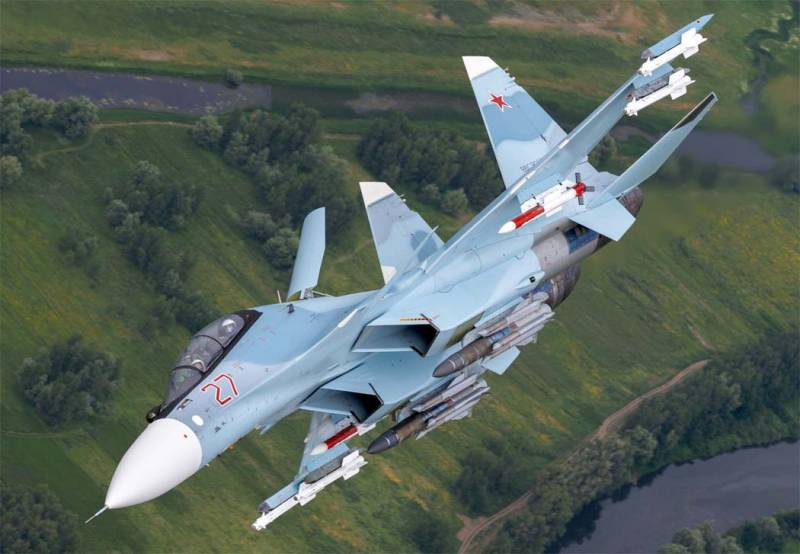
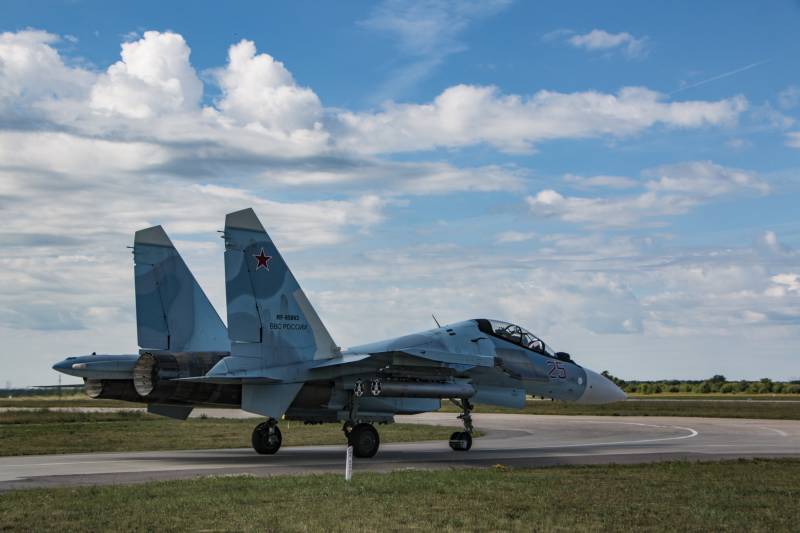
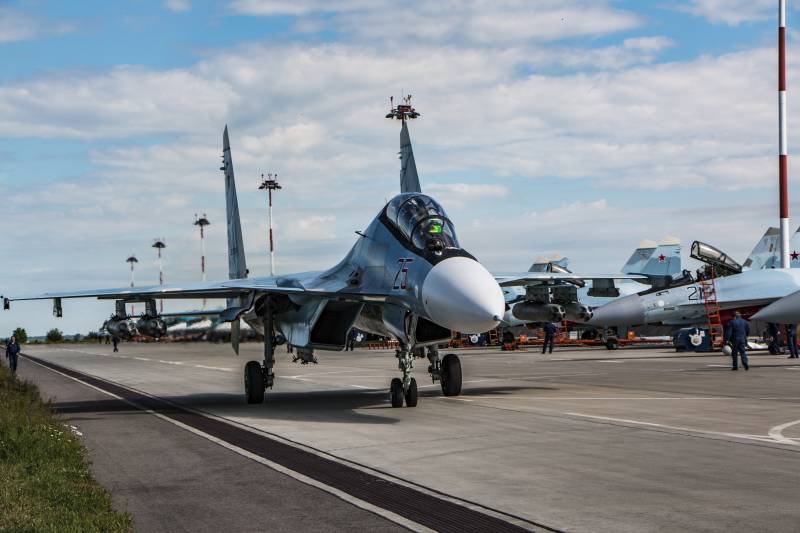
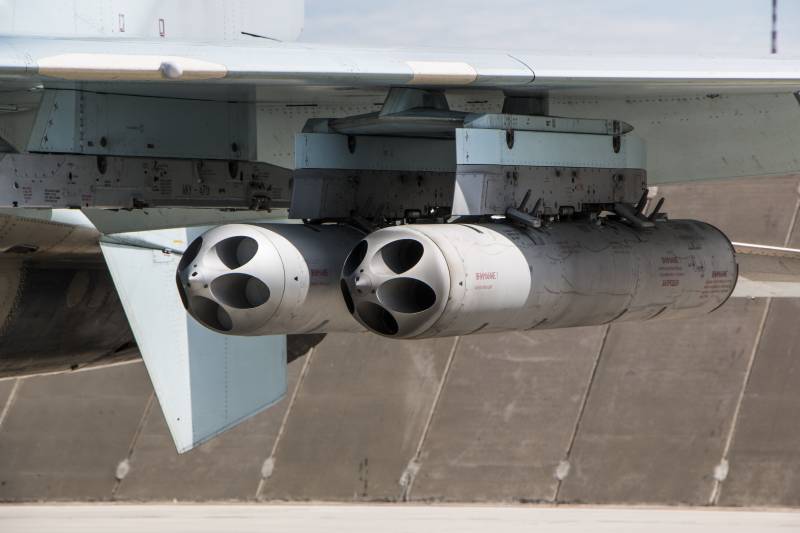
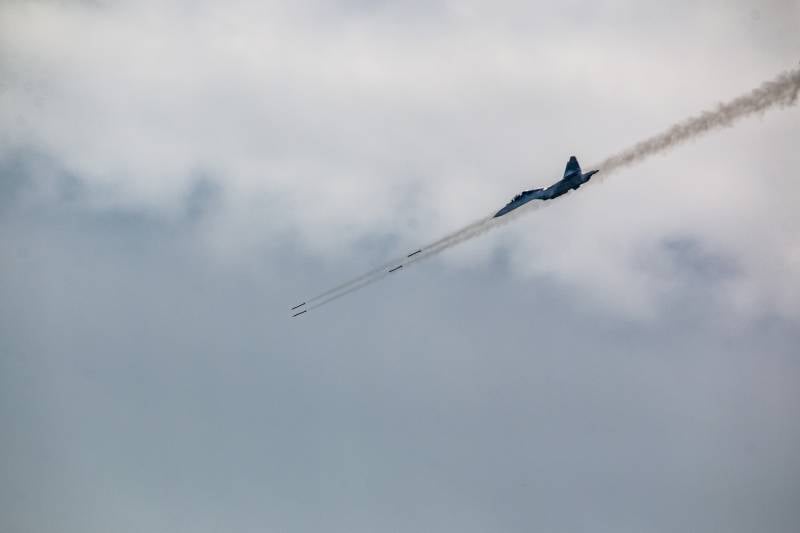
Information